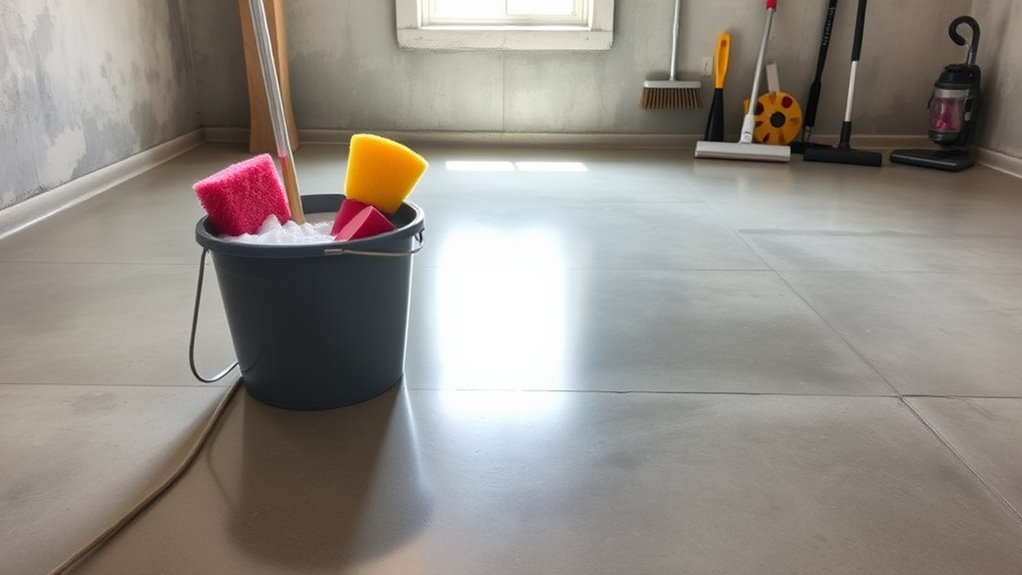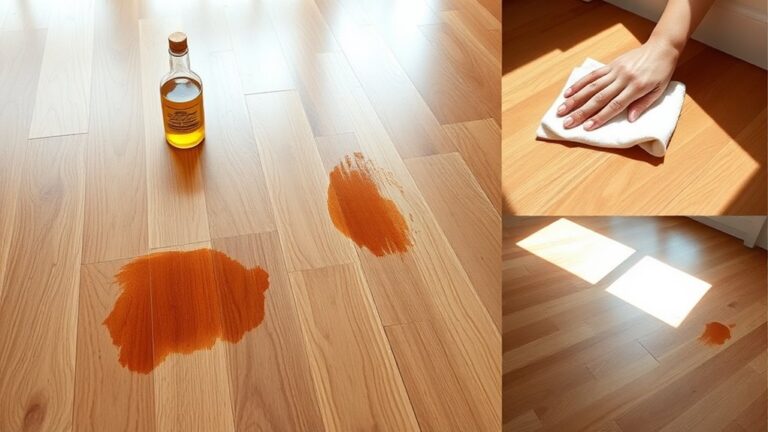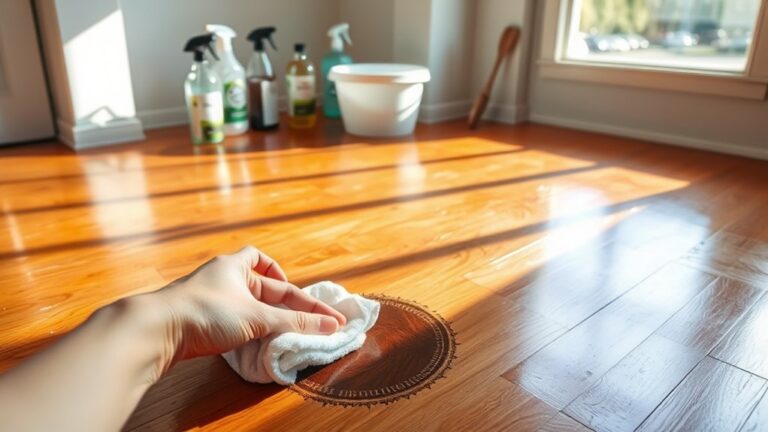To clean your concrete basement floor in 7 easy steps, start by clearing the area of clutter and sweeping up loose dirt. Apply a concrete cleaner or degreaser, then scrub the surface thoroughly with a stiff brush, focusing on stains and traffic spots. Rinse with clean water and allow the floor to dry completely. Finally, seal the sol to protect it from future wear. Follow these steps closely, and you’ll have a solid foundation to keep your basement floor looking great.
Clear and Prepare the Basement Floor
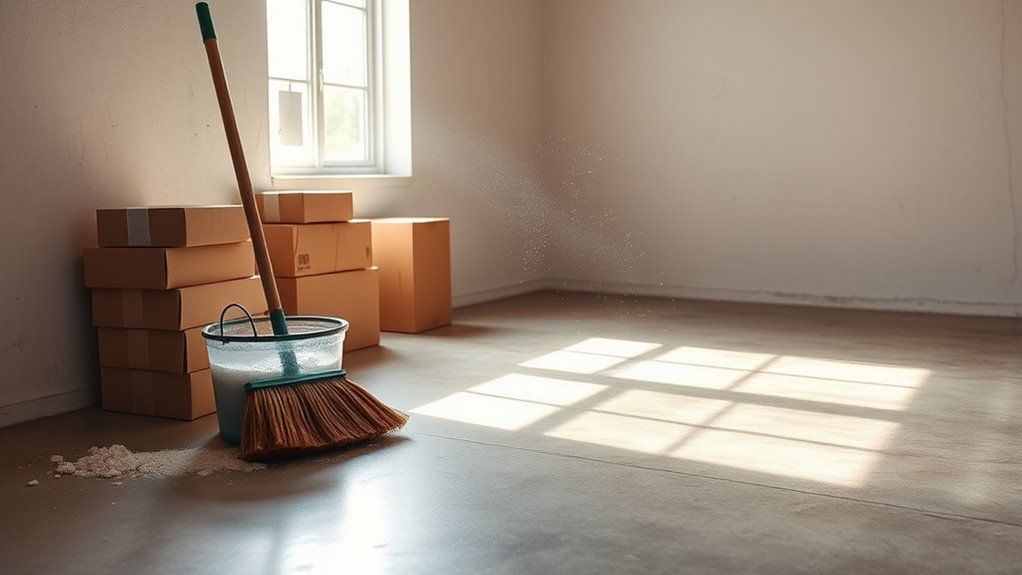
Before you begin cleaning, you’ll want to clear the basement floor of any furniture, boxes, or debris to confirm you have full access to the concrete surface. This essential basement preparation step confirms you can work freely and reach every inch of the floor without obstruction. Start by moving large items to another room or outside, then gather and dispose of smaller clutter like trash or broken objects. Floor clearing not only gives you space but also helps identify any cracks, stains, or damage that might need special attention during cleaning. Taking the time to thoroughly prepare your basement floor sets the foundation for a more effective, hassle-free cleaning process, letting you enjoy a clean, open space that feels truly yours.
Sweep and Remove Loose Debris
Once you’ve cleared the basement floor, you’ll want to sweep thoroughly to remove all loose dirt, dust, and debris. Proper dust removal and debris disposal set the stage for a truly clean surface. Here’s how to do it efficiently:
Thorough sweeping removes dust and debris, creating a clean foundation for a spotless basement floor.
- Use a stiff-bristled broom to gather dust and loose debris into manageable piles.
- Start sweeping from the farthest corner, moving toward the exit to avoid retracing dirty steps.
- Collect the piles with a dustpan, ensuring no small particles remain.
- Dispose of debris in a sturdy trash bag to prevent dust from spreading back onto the floor.
Apply a Concrete Cleaner or Degreaser
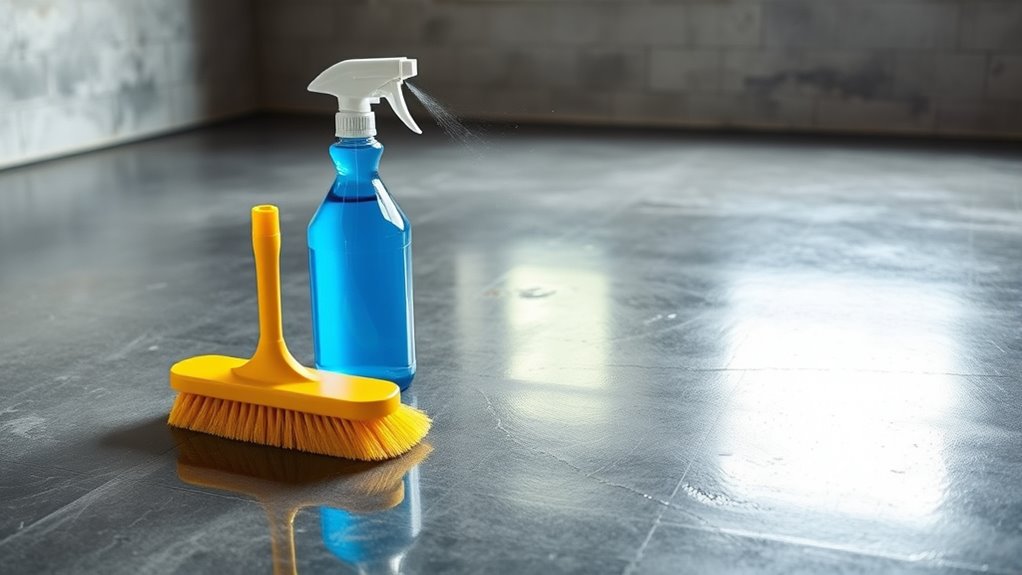
You’ll want to pick a cleaner or degreaser that’s designed specifically for concrete to tackle stains effectively. Apply the product evenly with a stiff brush or mop, making certain to follow the instructions closely for best results. Don’t forget to wear gloves and guarantee proper ventilation to keep yourself safe during the process.
Choosing Effective Cleaners
Although concrete floors are durable, they tend to absorb stains and dirt, so selecting the right cleaner is essential for effective cleaning. You’ll want to weigh your options between natural cleaners and commercial cleaners based on the floor’s condition and your preferences. Here’s how to choose:
- Assess Stain Type: Grease and oil need strong degreasers; dirt and dust call for milder solutions.
- Consider Natural Cleaners: These are eco-friendly and gentle, great for light stains or regular upkeep.
- Opt for Commercial Cleaners: Use these for tough stains or heavy grime, ensuring they’re concrete-safe.
- Check Product Ingredients: Avoid harsh acids that can damage concrete’s surface.
Techniques d'application
There are four key steps to applying a concrete cleaner or degreaser effectively. First, select the right application method—spraying, mopping, or scrubbing—based on your floor’s condition. Next, gather your cleaning tools like a stiff-bristle brush, mop, or sprayer. Then, apply the cleaner evenly, ensuring full coverage. Finally, let it sit per instructions before scrubbing or rinsing away.
| Étape | Recommended Tool |
|---|---|
| Apply cleaner | Pump sprayer or mop |
| Scrub stains | Stiff-bristle brush |
| Spread evenly | Rubber squeegee |
| Rinse floor | Garden hose or bucket |
| Dry floor | Towels or air dry |
Using these application methods with proper cleaning tools makes the process straightforward, freeing you to enjoy a spotless basement floor.
Précautions de sécurité
Before you start applying a concrete cleaner or degreaser, make certain you’re fully prepared to handle the chemicals safely. Wearing the right safety gear is essential to protect your skin and eyes. Also, be aware that wet concrete floors can become serious slip hazards, so take precautions to avoid falls. Here’s what you should do:
- Put on gloves, goggles, and a mask to shield yourself from fumes and splashes.
- Confirm the basement is well-ventilated by opening windows or running a fan.
- Keep the floor as dry as possible around your work area to reduce slip hazards.
- Have a bucket of water and towels ready for quick clean-ups if spills happen.
Following these steps will keep you safe and make the cleaning process smoother.
Scrub the Floor Thoroughly
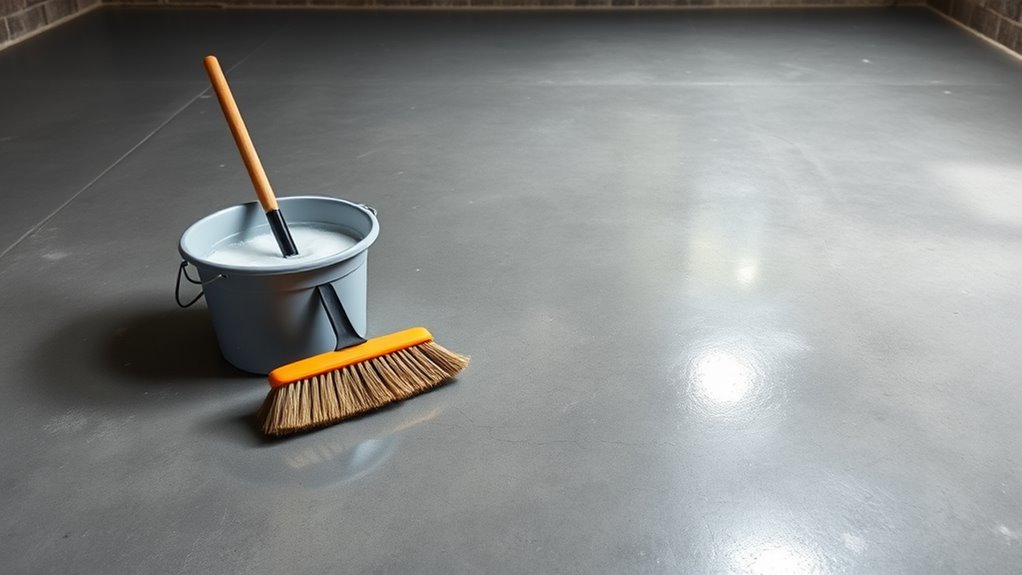
Once you’ve prepared the cleaning solution, you’ll want to scrub the floor thoroughly to remove dirt, stains, and grime embedded in the concrete. Start by choosing effective brushes—stiff-bristled ones work best for concrete surfaces. Use scrubbing techniques that allow you to apply firm, consistent pressure in circular motions to break down stubborn spots. Focus on high-traffic areas and visible stains, making certain to cover every inch methodically. You might want to divide the floor into sections to keep track of progress and avoid missing any spots. Keep your movements steady and don’t rush; thorough scrubbing guarantees a deep clean, freeing your basement floor from buildup. This step is essential for restoring the floor’s appearance and preparing it for any finishing touches or treatments.
Rinse With Clean Water
Two rounds of rinsing with clean water will help guarantee all the loosened dirt and cleaning solution are completely removed from your concrete basement floor. Use lukewarm water, as the water temperature plays a vital role in dissolving residue without damaging the surface. Follow these rinsing techniques:
- Pour water slowly across the floor, starting from the farthest corner.
- Use a soft broom or mop to guide water and loosen remaining grime.
- Collect dirty water with a wet vacuum or mop as you work towards the exit.
- Repeat the process for the second rinse with fresh water to confirm no residue remains.
This method frees your floor from leftover detergent and grime, leaving it fresh and ready for the next step.
Dry the Floor Completely
After thoroughly rinsing your concrete basement floor, you’ll want to guarantee it dries completely to prevent moisture-related issues like mold or mildew. Start by opening windows and doors to boost airflow. Use fans or a dehumidifier to accelerate drying—these drying techniques are essential for effective moisture management. If possible, direct fans toward the floor to help evaporate water faster. Keep in mind, concrete can retain moisture deep within, so allow plenty of time for drying, sometimes up to 24-48 hours depending on humidity. Avoid walking on the wet floor to maintain cleanliness and prevent re-soiling. Properly drying your basement floor not only keeps your space healthier but also prepares it for any further treatments or finishes you might want to apply later on.
Apply a Concrete Sealer for Protection
Once your basement floor is completely dry, applying a concrete sealer will protect it from stains, moisture, and wear. You’ll want to use a roller or brush to spread the sealer evenly, working in small sections to avoid puddles. Make sure to follow the manufacturer’s instructions for drying times and apply multiple coats if needed for the best protection.
Benefits of Concrete Sealer
Protection is key when it comes to maintaining your concrete basement floor, and applying a concrete sealer is one of the most effective ways to achieve it. The sealer benefits go beyond just aesthetics; it provides long term protection that lets you enjoy a cleaner, more durable surface. Here’s what you gain:
- Prevents moisture penetration, reducing mold and mildew risks.
- Guards against stains from oil, paint, or dirt.
- Enhances concrete’s resistance to wear and tear, extending its lifespan.
- Makes cleaning easier by creating a smooth, sealed surface.
Application Tips and Tricks
To get the most out of your concrete sealer, you’ll want to apply it correctly. Start by thoroughly cleaning your floor using proper cleaning tools to remove dust, grease, and debris. Make certain the surface is completely dry before application. Use a roller or sprayer to apply the sealer evenly, working in small sections to avoid streaks or missed spots. Follow the manufacturer’s instructions for drying times and apply a second coat if needed for extra protection. Maintenance tips include regular sweeping and damp mopping with mild cleaners to preserve the sealer’s finish. Avoid harsh chemicals and abrasive tools that can damage the surface. Proper application and care will guarantee your basement floor stays protected and looks great for years to come.

